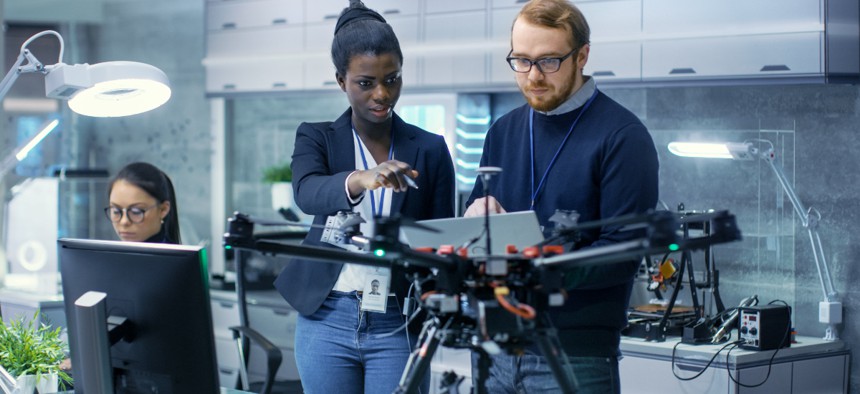US needs improved regulation to foster drone R&D

gorodenkoff/Getty Images
Unmanned aircraft system innovation is hindered by the current regulatory framework, according to witnesses at a congressional hearing.
Research and development to advance Unmanned Aircraft Systems is critical but currently burdened by regulation, according to speakers at a House Space and Aeronautics Subcommittee hearing on Thursday.
Subcommittee Chairman Brian Babin, R-Texas, noted that there are two challenges to deploying the next-generation of autonomous systems in the U.S.: research and development and regulatory frameworks.
“Due to the delays in integrating UAS into the National Airspace System, these technologies are unable to reach their maximum potential,” Babin said. “As a result, U.S. companies are going overseas to conduct UAS R&D, which directly impacts our national security and economic competitiveness. Our goal today is to better understand the research underway to overcome these barriers and how we can streamline UAS and AAM [Advanced Air Mobility] integration.”
Babin further expressed concern about China’s technology and market dominance in this area, citing national security concerns. He noted the importance of American R&D and manufacturing to address this concern.
While UAS can help firefighters put out fires and other first responders to deliver medical supplies or perform infrastructure inspections, regulation and R&D challenges are further hindering this progress and the scaled, widespread use of the technology.
“The goal of using drones and drone traffic management or UAS and UAS traffic management—UTM—is to create a second shift environment where you can continue the operations under low visibility condition by remotely operating these drones outfitted with water and retardant capabilities and managed by UTM in a box that is basically ensuring that their trajectories are de-conflicted with each other and they're monitoring the trajectories for safe operations,” Parimal Kopardekar, director of the NASA Aeronautics Research Institute, said.
One of the main issues discussed during the hearing was the existing burdensome regulations for UAS operation, which purportedly hinder innovation and R&D efforts.
“The absence of a viable UAS regulatory framework continues to be the most significant barrier to integration [of UAS into the national airspace], and a robust R&D program will only succeed if accompanied by a reasonable regulatory environment,” Lisa Ellman, executive director of the Commercial Drone Alliance, said.
For example, Ellman notes that a company designing a UAS weighing 55 pounds or more “must currently wait years to begin conducting R&D on its own property due to lengthy approval processes. While innovative programs like BEYOND and test sites try to offer alternative pathways, these programs are also often plagued by lengthy regulatory approval processing times.”
She urged Congress to address these issues by further utilizing current resources like BEYOND—an FAA pilot program to help collect data and establish standards—and UAS test sites, allow programs to function how they were designed, focus R&D efforts on “validating future UAS capabilities and complex airspace,” support growing UAS in AAM manufacturing and integrate counter-drone technologies into this ecosystem, among other things.
Small UAS technology development also faces regulatory barriers. For example, the government only has 15 approved platforms from which to purchase. And supply chain vulnerabilities and the inability of counter-UAS technology companies to test and perform R&D in the U.S. have ultimately created national security concerns. According to the speakers, developing standards will also help, but the standards cannot be so restrictive as to hinder innovation, and it may even be too early to develop such standards.
Furthermore, according to the speakers, R&D efforts should focus on disaster relief and firefighting, UAS traffic management and congested airspace navigation, among other things.
In addition to addressing regulation, it is also important for Congress to fund R&D efforts.
“Government funding has been a powerful driver in pushing technology from the laboratories to end-user adoption, crossing the valley of death that many innovations never bridge,” said Jamey Jacob, executive director of the Oklahoma Institute for Research and Education.
The speakers noted the importance of building a robust workforce to support the UAS industry through partnerships with universities and other educational institutions to develop and train the workforce. However, there are limitations.
“The university impact is really limited by access to the airspace and being able to test the systems,” Jacob said. “We’ve certainly found that not only in terms of what we’re evaluating on the counter-UAS side, but then how we take this out to the community. That’s where we start to educate the public about how UAS can be used for both good and for ill, how they’re going to be integrated in the airspace, and we start to be able to spark those ideas from community members about not only acceptance of the technology, but also entrepreneurial ideas about how they can use the systems to be able to start up new businesses or engage with their community.”
The hearing also served as a legislative hearing to discuss the National Drone and Advanced Air Mobility Initiative Act which seeks to provide a coordinated federal initiative to fast-track civilian UAS and advanced air mobility R&D.


